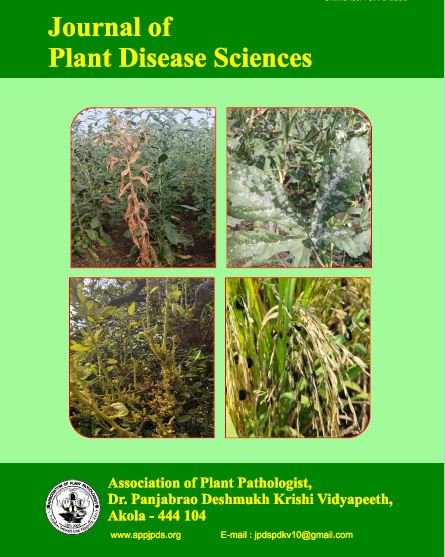Biological Management of Wilt in Pigeonpea Caused by Fusarium oxysporum f. sp. udum
DOI:
https://doi.org/10.48165/jpds.2024.19.02.08Keywords:
Bioagents, Fusarium udum, Pigeonpea, Wilt, PhytoextractsAbstract
Pigeonpea (Cajanus cajan L. Millspaugh) is a highly significant legume crop in India, serving as a crucial source of protein. However, the crop is susceptible to a wide array of pathogens, with over 100 known diseases affecting it. Among them, wilt caused by Fusarium oxysporum f. sp. udum is one of the most devastating. An in vitro experiment was conducted to evaluate eco-friendly management strategies against pigeonpea wilt. The study assessed the efficacy of eight bioagents (six fungal and two bacterial) and eight phytoextracts. Among the bioagents, the local strain of Trichoderma asperellum exhibited the highest mycelial growth inhibition (90.26%). Among the phytoextracts, neem demonstrated the highest inhibition at 10% and 20% concentrations (69.56% and 85.11%, respectively), followed by garlic (67.26% and 84%, respectively).Pigeonpea is known for its ability to restore soil fertility by fixing atmospheric nitrogen, enhancing phosphorus availability, and improving soil properties. It is the second most important pulse crop after chickpea in India, particularly in rainfed agriculture. Despite its significance, pigeonpea suffers from several economically important diseases, including sterility mosaic, Fusarium wilt, Phytophthora blight, Macrophomina root rot, Alternaria blight, stem canker, and powdery mildew.In India, wilt incidence ranges from 10% to 60% (Nene et al., 1996), with potential yield losses reaching up to 100% in susceptible cultivars (Pande et al., 2013). In Maharashtra, pigeonpea is primarily grown as a kharif crop on marginal lands by resource-poor farmers due to its resilience against water and nutrient stress. In 2021-22, Maharashtra recorded the highest area (14.18 lakh ha), production (16.49 lakh tonnes), and productivity (1163 kg/ha) for pigeonpea.References
Aishwarya, D. S. and Somasekhara, Y. M. 2017: Evaluation of botanicals, fungicides, and bioagents against pigeonpea wilt (Fusarium oxysporum f. sp. udum). Journal of Plant Disease Sciences, 10(1): 92-98.
Arora, D. K. and Upadhyay, R. K. 1978: Effect of fungal staling growth substances on colony interaction. Plant and Soil, 49: 685-690.
Dennis, C. and Webster, J. 1971: Antagonistic properties of Trichoderma species group and hyphal interaction. Transactions of the British Mycological Society, 57: 363-396.
Mishra, R. S. and Kumar, S. 2015: Evaluation of plant-extracts, bio-agents, and fungicides against Fusarium oxysporum f. sp. udum causing pigeonpea wilt. Journal of Advanced Life Sciences, 10(4): 439-447.
Nene, Y. L., Sheila, V. K., and Sharma, S. B. 1996: A world list of chickpea and pigeonpea pathogens (Fifth Edition). Patancheru A.P., India: International Crops Research Institute for the Semi-Arid Tropics, pp. 27.
Nene, Y. L. and Thapliyal, P. N. 1979: Fungicides in Plant Disease Control. Oxford and IBH Publishing House, New Delhi, pp. 163.
Pande, S., Sharma, M., and Guvvala, G. 2013: An updated review of biology, pathogenicity, epidemiology, and management of wilt disease of pigeonpea (Cajanus cajan (L.) Millsp.). Legume Research, 26(2): 1–14.
Prasad, P. S., Saifulla, M. N., Mallikarjuna, P. R., Thimmegowda, R. N., and Lakshmipathy, R. 2012: Integrated disease management of pigeonpea wilt (Fusarium udum Butler). Madras Agricultural Journal, 99(10): 811-814.
Rana, D., Thakur, B. R., and Rana, S. K. 2020: Efficacy of plant extracts and bioagents against Fusarium wilt of chickpea. Plant Disease Research, 35(2): 122-126.
Rajvanshi, N. K., Chandra, S. A., and Kumar, A. 2018: Efficacy of botanicals, bio-agents, and fungicides against Fusarium udum causing wilt disease of pigeonpea in vitro. Journal of Pharmacognosy and Phytochemistry, SP 4: 197-198.
Sahu, S., Sahu, M. K., Tiwari, R. K., and Khare, S. N. 2017: In-vitro evaluation of antagonistic potential of fluorescent Pseudomonas and Trichoderma against Fusarium oxysporum f. sp. udum inciting wilt in pigeonpea (Cajanus cajan L. Millsp.). Research Journal of Agricultural Sciences, 8(4): 832-837.
Vincent, J. M. 1947: Distortion of fungal hyphae in presence of certain inhibitors. Nature, 159: 850.

